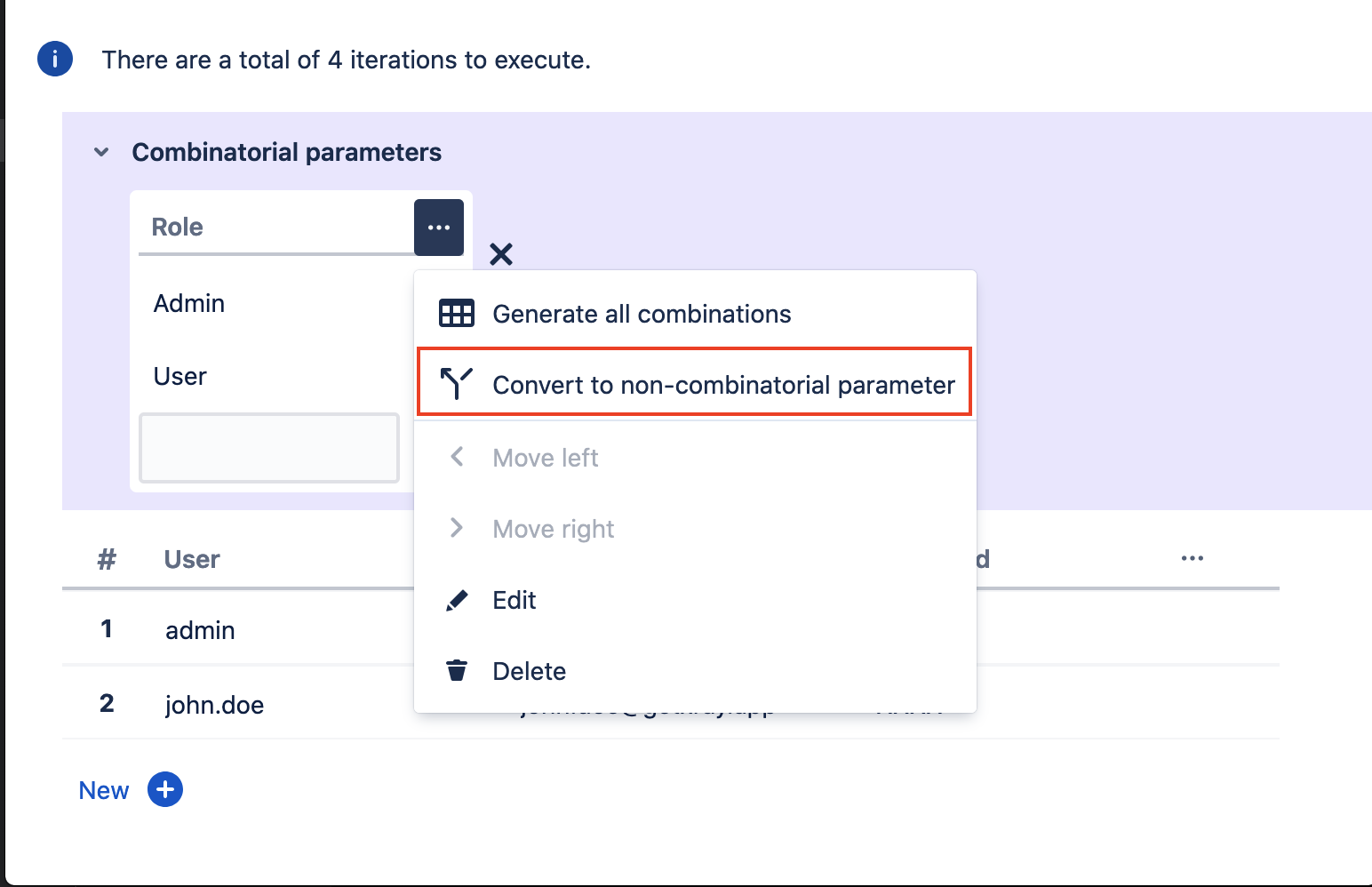Page History
...
Parameters are embedded within the test specifications using the following notation: ${PARAMETER_NAME}. Parameter names are case-sensitive.
This notation is used to reference parameters within the test steps. You can reference parameters on the Action, Data, Expected Result, and even on any test step custom fields that are text-based.
...
| Info |
|---|
Currently, the test parameterization feature is only available for Manual Tests. Xray will support defining parameters and use datasets on BDD and generic test types as well. |
Datasets
| Anchor | ||||
|---|---|---|---|---|
|
The parameters, along with their values, are defined within a dataset. A dataset is a collection of data represented with a tabular view where every column of the table represents a particular variable (or parameter), and each row corresponds to a given record (or iteration) of the dataset.
...
- Global - managed by Jira administrators (to learn more about Global lists, click here).
- Project - managed by project administratorsadministrators (to learn more about Project lists, click here).
Global lists can not be used directly. These must be included in the project by the project administrator before they can be accessed within a dataset of that project.
...
5.1. Next to each column, there is an options button. Clicking this button will reveal a menu with options for Editing, Deleting, and Converting parameters.
5.2. Click on "Convert to combinatorial parameter."
...
6.1. Next to each combinatorial column, there is an options button. Clicking this button will reveal a menu with options for Editing, Deleting, and Converting parameters.
6.2. Click on the "Convert to non-combinatorial parameter".
...
7.1. Next to each combinatorial column, there is an options button. Clicking this button will reveal a menu with options for Editing, Deleting, Converting parameters, and Generating all combinations.
7.2. Click on the "Generate all combinations." A confirmation dialog will appear. Confirming the changes will apply the cartesian product between the combinational parameter values and the seeding parameter rows.
...
7.3. After having performed all changes in the dataset, you need to press the "Save" button in order to persist the dataset into the database.
Importing a dataset from a CSV file
Besides defining a dataset by creating parameters and setting their values directly using the Xray UI, it is also possible to import an existing dataset from a CSV file.
In order to import a CSV file:
1. Open the dataset dialog.
2. Choose the "Import from CSV" option available on the Import dropdown button (located on the empty state view or on the dataset main button toolbar). A dialog will appear.
3. Select and fill the following options:
- File - find a local CSV file with the desired dataset
- CSV delimiter - defaults to "," but you can choose any other character
8. Move left/right:
You can re-order any parameters in your dataset, by selecting the "Move left/right" option.
8.1. Open the options menu in either a Combinatorial or non-combinatorial (seeding) parameter, you will have a "Move left/right" option available. Notice that if the parameter is already place on the most outer left (right) position, the "Move left" (right) option is not available.
8.2. Select the move left/right option, This will swap the parameters positions.
Importing a dataset from a CSV file
Besides defining a dataset by creating parameters and setting their values directly using the Xray UI, it is also possible to import an existing dataset from a CSV file.
In order to import a CSV file:
1. Open the dataset dialog.
2. Choose the "Import from CSV" option available on the Import dropdown button (located on the empty state view or on the dataset main button toolbar). A dialog will appear.
3. Select and fill the following options:
- File - find a local CSV file with the desired dataset
- CSV delimiter - defaults to "," but you can choose any other character
- File encoding - defaults to UTF-- File encoding - defaults to UTF-8
- Overwrite existing parameter values - if checked, this option will delete any values from existing parameters
- Create new parameters - If checked, it will create non-existing parameters automatically, based on the CSV column name. Otherwise, it will just append/update the values on the existing parameters.
based on the CSV column name. Otherwise, it will just append/update the values on the existing parameters.
4. Press "Import" to import the external dataset.
| Info | ||
|---|---|---|
| ||
You can also import combinational parameters. Any parameter with an asterisk suffix will be considered a combinational parameter. E.g., Quality*. In this case, the "Create new parameters" option must be enabled. |
Exporting a dataset to a CSV file
To export a dataset to a CSV file:
- Open the Dataset dialog.
- Click the options button next to the import button. Clicking this button will reveal a menu with options for Export to CSV and Delete.
3. Click the Export to CSV. A file should be downloaded4. Press "Import" to import the external dataset.
| Info | |||
|---|---|---|---|
| |||
The delimiter used to generate the CSV file is a commaYou can also import combinational parameters. Any parameter with an asterisk suffix will be considered a combinational parameter. E.g., Quality*. In this case, the "Create new parameters" option must be enabled. |
Overriding a dataset in a test plan or test execution
...











